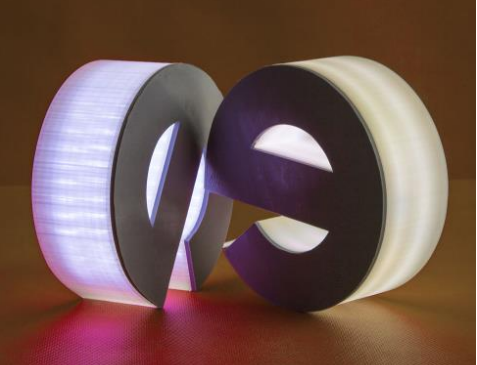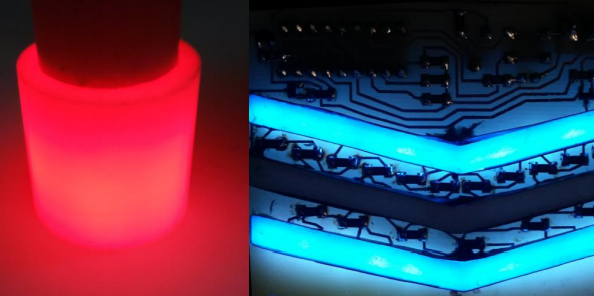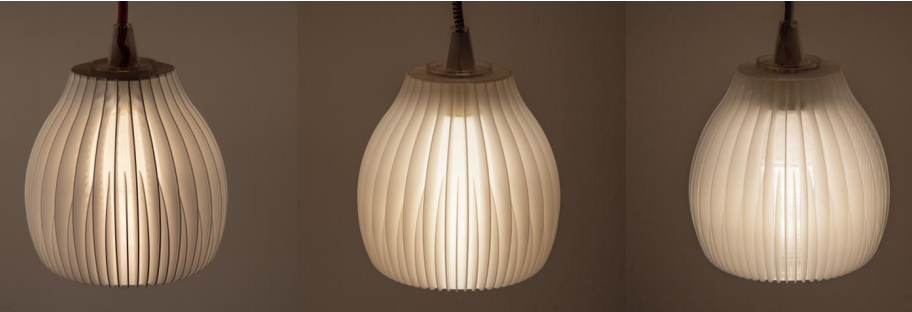VIVASA Design to Transform Lighting Industry with Eco3D PLA Light Diffusion Filament
 The interior design and lighting industry is famous for entertaining and wowing us with one new look and concept after another, from modern bohemian and ultra hip to funky and futuristic. Commercial lighting is a place where consumers can exhibit a great deal of style as well, but with one difference–this is usually either for advertising or is completely utilitarian. Both usage and functionality are crucial, as it comes down to the bottom line. LED lighting has become very popular for use in places like offices, hotels, parks, airports, and more.
The interior design and lighting industry is famous for entertaining and wowing us with one new look and concept after another, from modern bohemian and ultra hip to funky and futuristic. Commercial lighting is a place where consumers can exhibit a great deal of style as well, but with one difference–this is usually either for advertising or is completely utilitarian. Both usage and functionality are crucial, as it comes down to the bottom line. LED lighting has become very popular for use in places like offices, hotels, parks, airports, and more.
While we are highly sensitive to lighting and how it affects visuals, mood, and more, it’s something we take for granted almost as much as air. And something most of us rarely take into account is what materials are responsible for actual lighting, aside from the shape, color, and style–whether it’s for lighting on a panel, above a cash register, in a bedroom, or softly working as a nightlight for a little one.
 For individuals like Ondrej Vinter, the founder of VIVASA Design, and his team, lighting materials and filters are something they put a great deal of intense thought to. And while they aren’t out to re-create the wheel, with a new 3D printing material called Eco3D filament, they may soon transform, sharpen, soften, and re-shape the world of lighting and filters. VIVASA is headquartered in the Czech Republic, and their team is dedicated to creating unique consumption materials for FDM 3D printers.
For individuals like Ondrej Vinter, the founder of VIVASA Design, and his team, lighting materials and filters are something they put a great deal of intense thought to. And while they aren’t out to re-create the wheel, with a new 3D printing material called Eco3D filament, they may soon transform, sharpen, soften, and re-shape the world of lighting and filters. VIVASA is headquartered in the Czech Republic, and their team is dedicated to creating unique consumption materials for FDM 3D printers.
As our needs vary, we humans have always had the gift of finding ways to transform light, from getting out of sunshine or shielding our view to varying candlelight, to manipulating power and electricity in a variety of ways. Lighting has evolved today into an industry that burns brightly in nearly every marketplace and sector, from home goods to cars. And LEDs are burning brightly nearly everywhere you look, leading the way for a variety of different formats today.
Vinter, with a background in automotive lighting, began working with his team to improve light distribution but in a very new way, via 3D printed materials. While he sees this as having other potential applications, Vinter believes their new material will offer greater latitude to professionals in the lighting industry.
“I have some experience from my previous job in the automotive industry with a company that produced car lamps using plastic parts from material for homogeneous light distribution at rear lamps of cars,” Vinter explained to 3DPrint.com. “This material is produced by injecting molding or silicon casting, but does not exist in materials for 3D printers.”
“After some months of development, we have developed new material for FDM printers based on PLA, which is comparable with milky materials for injection molding, and offer homogeneous light distribution,” said Vinter. “We have done some analysis with my ex-colleagues from their company to compare new material with currently used materials like PLA Natural and White, with interesting conclusions regarding usage.”
Known as a light diffusion filament, Eco3D PLA is composed of biodegradable additives, and is even considered completely food safe, although we do not foresee you snacking on it any day soon, knock on wood. Manufactured in 1.75mm and 2.85mm with a tolerance of .05mm and a temperature resistance at 65° C, the filament is generally used by light designers–and more specifically–mechanical and optical designers.
The VIVASA team sees this 3D printing filament as a way to offer improvement over typical PLA white and natural, in that there are a lot of cons in using those particular materials for lighting materials.
PLA White can have downsides due to ‘high dumping’ of light transmittance leading to the necessity for slim walls, which can cause other issues that are both mechanical and related to heat, as the filament may not be as resistant to a higher temperature.
PLA Natural causes issue in terms of high light transmittance with ‘low diffusion effect.’ There are also visible ‘hotspots’ from LED lights. There are often visible inner partials, as well as problems with nonhomogeneous lighting distribution.
In use for signs, Eco3D is beneficial as it evenly and smoothly distributes light in a proper LED setup. For electronics requiring filters, the 3D printed material can be used as filters for diffusion, assisting in reaching the appropriate light transmittance with thick walls, up to 5mm.
Due to the research and development time spent on this project, the VIVASA team was able to create a filament that in the end is shown to display an outstanding rate between the light transmittance, diffusivity, and mechanical endurance in relation to transmittance. They see it as a perfect choice for those interested in 3D printing light shields and lamp shades.
What are your thoughts on this revolutionary new 3D printing material for the lighting industry? Discuss your thoughts in the Eco3D PLA Light Diffusion 3D Printing Filament forum thread over at 3DPB.com.
Subscribe to Our Email Newsletter
Stay up-to-date on all the latest news from the 3D printing industry and receive information and offers from third party vendors.
Print Services
Upload your 3D Models and get them printed quickly and efficiently.
You May Also Like
3D Printing Financials: Velo3D Looks to Bounce Back with Defense Deals
Velo3D (OTCQX: VLDX) is working hard to get back on track. The metal 3D printing company brought in $9.3 million in revenue during the first quarter of 2025, slightly below...
Formlabs CEO Says Company Is Caught in US-China Trade Fight
Max Lobovsky, the CEO and co-founder of Formlabs, raised concerns about the challenges his company faces due to ongoing global trade tensions, particularly between the United States and China, in...
University of Illinois Launches AM Research Center with $8M DoD Backing
The Department of Defense (DoD) has awarded $8.15 million to the University of Illinois Urbana-Champaign to support the establishment of an additive manufacturing (AM) research center at the Grainger College...
3D Printing News Briefs, May 3, 2025: Executives, Awards, & a 3D Printing Factory
We’re focusing on additive manufacturing business news today, as both Velo3D and PostProcess Technologies announced changes to their Boards of Directors. Sandvik Metal Powder has a new president, and Klas...































